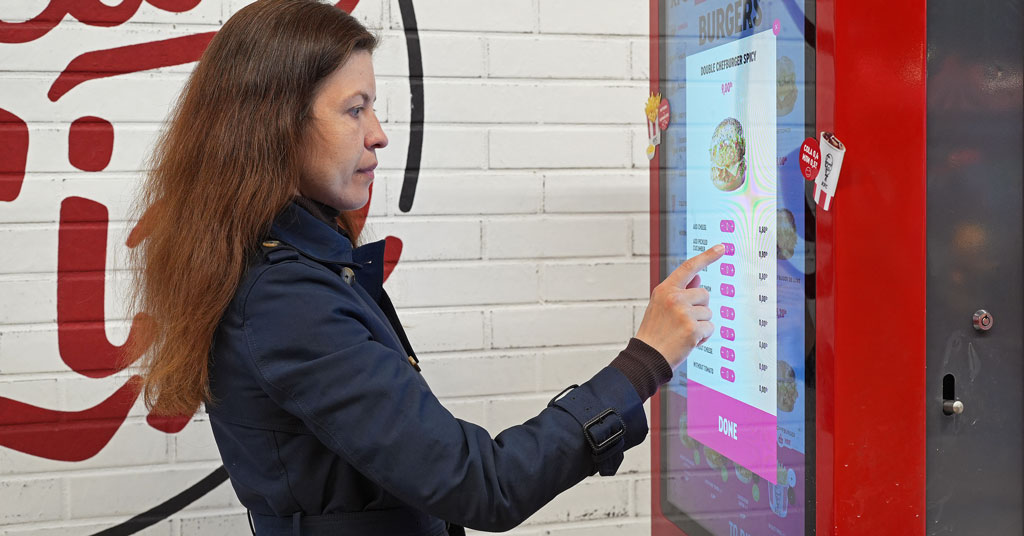What's Next for QSR Tech

Change is constant in the quick service restaurant (QSR) industry and the only way forward is innovation. What once seemed like futuristic concepts are now becoming everyday realities, transforming how restaurants serve customers, manage operations, and create memorable dining experiences. From AI-driven technologies to seamless payment systems, the next wave of tech advancements will push the boundaries of what’s possible, making operations faster, more efficient, and increasingly personalized.
In 2025, QSR leaders must stay ahead of the curve to meet growing consumer expectations. Here are some of the key technologies that are reshaping the industry and a look at the tools that will define the future of dining.
Self-ordering kiosks everywhere as the new standard for customer interaction
In 2024, we saw self-ordering kiosks become a familiar feature in QSR dining rooms. However, 2025 will be the year they go beyond the counter. Major brands are already piloting kiosk integration in drive-thru lanes, enabling customers to independently place complex orders without waiting for a staff member.
These kiosks are also becoming smarter. New-generation models will incorporate multilingual interfaces and AI-driven upsell prompts that dynamically adjust to a customer’s preferences. Expect to see kiosks in nontraditional locations too—think airports, stadiums, and even pop-up QSR concepts.
AI-driven order accuracy from insights to execution
Human error has long been a challenge in high-volume QSR operations. AI is stepping in to solve this issue with systems that review orders in real time, cross-referencing them with historical trends and customer preferences.
In 2025, AI will also be embedded directly into kitchen management. For instance, AI platforms will monitor preparation times and match them to order expectations, reducing delays during peak periods. This technology won’t just improve accuracy—it will provide actionable data for optimizing menu designs and ingredient sourcing.
Voice AI for drive-thrus providing the human touch at scale
The rise of AI-powered voice assistants will bring a revolution to the drive-thru experience. Today, customers expect speed and clarity; tomorrow, they’ll expect personalization.
In 2025, voice AI will go beyond simple order-taking. These systems will recognize returning customers by voice or license plate (when paired with computer vision technology), allowing them to reorder their “usual” with a simple confirmation. Advanced systems will handle order modifications seamlessly, removing the frustration of repeating requests or correcting errors.
Major chains are already reporting a reduction in drive-thru wait times by up to 20 percent in locations piloting voice AI—a trend likely to gain traction across the industry.
Computer vision for drive-thrus optimizing customer flow and efficiency
While computer vision has made waves in inventory management, its most exciting application in 2025 will be in the drive-thru. Cameras set up along the drive-thru lanes will be used to monitor the flow of vehicles and optimize order timing.
These systems will track vehicle positioning, measure wait times, and predict peak periods, helping operators adjust staffing and prepare orders in advance. As a result, drive-thru throughput will increase, reducing bottlenecks and ensuring customers have a smoother, faster experience. Computer vision will also be integrated with voice AI, creating a fully optimized, frictionless ordering experience.
Frictionless payments creating a seamless end to the customer journey
If there’s one area where customers demand speed and convenience, it’s payment. In 2025, frictionless payment systems will extend beyond tap-and-go credit cards to include biometric payments, where customers can pay with a fingerprint or facial scan.
Meanwhile, mobile apps will continue integrating payment options alongside loyalty programs, creating a single, seamless interface for ordering, earning rewards, and completing transactions.
Some QSR operators are already experimenting with subscription-based models for frequent customers, enabling unlimited drinks or meal bundles for a flat monthly fee. This innovation leverages payment technology to build loyalty and drive recurring revenue.
What operators need to know
The pace of technological change is accelerating, and the QSRs that adapt quickly will be the ones leading the pack. But adopting these technologies is not just about staying competitive—it’s about transforming how restaurants operate and connect with their customers.
2025 will require operators to rethink how they deploy their workforce. As automation handles repetitive tasks, employees will be freed to focus on high-touch customer interactions and strategic roles. The challenge is ensuring staff are trained to work alongside these technologies, rather than being replaced by them.
By leaning into these trends—investing in AI, leveraging computer vision, and creating frictionless experiences—QSR brands can set themselves apart. The future isn’t just about faster service; it’s about smarter, more meaningful service that builds lasting customer loyalty.
Thibaud Denolle is the CEO of Acrelec Americas, a global technology company focused on reinventing the customer experience for restaurant and retail brands.
Share this Feature
Recommended Reading:
| ADVERTISE | SPONSORED CONTENT |
FRANCHISE TOPICS
- Multi-Unit Franchising
- Get Started in Franchising
- Franchise Growth
- Franchise Operations
- Open New Units
- Franchise Leadership
- Franchise Marketing
- Technology
- Franchise Law
- Franchise Awards
- Franchise Rankings
- Franchise Trends
- Franchise Development
- Featured Franchise Stories
| ADVERTISE | SPONSORED CONTENT |

$50,000
$300,000





 The multi-unit franchise opportunities listed above are not related to or endorsed by Multi-Unit Franchisee or Franchise Update Media Group. We are not engaged in, supporting, or endorsing any specific franchise, business opportunity, company or individual. No statement in this site is to be construed as a recommendation. We encourage prospective franchise buyers to perform extensive due diligence when considering a franchise opportunity.
The multi-unit franchise opportunities listed above are not related to or endorsed by Multi-Unit Franchisee or Franchise Update Media Group. We are not engaged in, supporting, or endorsing any specific franchise, business opportunity, company or individual. No statement in this site is to be construed as a recommendation. We encourage prospective franchise buyers to perform extensive due diligence when considering a franchise opportunity.